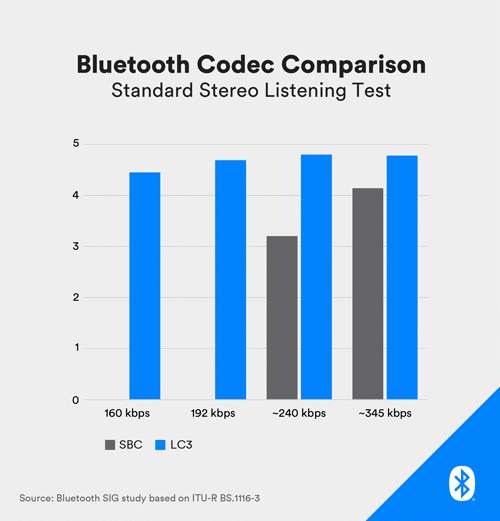I first heard about Bluetooth LE (Low Energy)- part of Bluetooth 4.0- in 2013 with RFDuino board, and it came to prominence once Android 4.3 added support later this year. Bluetooth LE is using to transmit messages using as little as energy as possible for example to synchronize data between a smartphone and a smartwatch.
But if you ever had to transmit audio, you had to rely on Bluetooth Classic which, albeit considering low power, consumes more energy. But you should soon have much longer battery life on your Bluetooth headphone or battery-operated speaker, as the Bluetooth SIG has just announced Bluetooth LE Audio which adds a new codec and support for multi-stream and broadcast audio.
The new high-quality, low-power audio codec used in the new Bluetooth standard is called the Low Complexity Communications Codec (LC3). The chart above shows the results of listening tests between LC3 and SBC codecs at different bitrates with a score from 0 to 5 representing audio quality. We can see LC3 @ 160 Kbps offers similar, even slightly better, quality than SBC at 345 Kbps.
That’s this lower bitrate together with the use of the LE radio that lead to power savings that will enable product developers to either lengthen the battery life or reduce the form factor with a smaller battery.
Bluetooth LE Audio support both Multi-Stream Audio to enable the transmission of multiple, independent, synchronized audio streams between an audio source device (e.g. a smartphone) and one or more audio sink devices, and Broadcast Audio to allow on audio source device to broadcast one or more audio streams to an unlimited number of audio sink devices. The latter feature will allow Bluetooth Audio sharing between friends and family, or to multiple users at an airport or other public places.
Finally, Bluetooth LE Audio adds support for Bluetooth hearing aids with wireless calling, listening, and watching, but it’s not very clear which specific features make this possible, as Bluetooth hearing aids have been available for a while. One easy-to-guess advantage of Bluetooth LE Audio for hearing aid is the ability to use smaller batteries. , but there must be more to it.

The specifications are expected to be released sometime in H1 2020, but Nordic Semi is already showcasing a Bluetooth LE Audio evaluation platform at CES 2020. The kit specifications are very interested as the evaluation kit is based on nRF52832 Bluetooth LE SoC, Cirrus Logic’s CS47L35 smart codec, Packetcraft’s Bluetooth LE host stack and link-layer supporting Bluetooth LE Audio, and a BLE Audio Software Development Kit (SDK). That means there’s apparently no need for hardware changes, and only the firmware and software stacks need to be updated.
You can find out more on Bluetooth LE Audio on Bluetooth SIG website, the announcement blog, and Nordic Semi’s press release.

Jean-Luc started CNX Software in 2010 as a part-time endeavor, before quitting his job as a software engineering manager, and starting to write daily news, and reviews full time later in 2011.
Support CNX Software! Donate via cryptocurrencies, become a Patron on Patreon, or purchase goods on Amazon or Aliexpress






Does anyone have an idea, why they come up with a new codec instead of implementing opus?
LC3 is developed by Fraunhofer, the lab that created MP3 and AAC.
Since Bluetooth SIG and Fraunhofer did not open the spec yet we don’t know how LC3 is compared to Opus, but I guess Fraunhofer knows what they are doing.
https://www.iis.fraunhofer.de/en/ff/amm/communication/lc3.html
There is some code available from ETSI to evaluate the LC3 codec. I suppose someone could retro engineer it, but I’m not sure if there are patents on some implemented techniques, and how many. And I can’t find that info anywhere.
There’s a short discussion on Hacker News about LC3 vs OPUS – https://news.ycombinator.com/item?id=21982964
They have links to some technical documents one of them states:
For years no one cared about the old horrifying codec, now aptx came and instead of using a standard or improving upon the standard, the usual old suspects smell again the royalty millions. I still believe opus would be good enough for the use case.
But bad luck, same as introducing dab+ along with aac once mp2’s patents as used in dab expired.
I hope video will go ahead with av1, just to hope audio and telephony will follow suit in a couple of years.
Duh! So that they can collect another few billion in royalties. And that’s the only reason to make a up a new codec chock full of patented algorithms.
I hope everyone who uses this ignores LC3 and implements Opus or similar instead.
Why didn’t they simply use MP3 and avoid recoding? Maybe because all of the patents on it have expired??????
Uhm, in as much as I agree about the royalties part, you’re not longer standards compliant if you implement some other codec. Just look at the AptX and LDAC mess we already have. This is simply not a good idea. We need solid standards for a reason or this mess is going to continue forever.
Mp3 has far too much latency for voice and similar rt audio (i.e. tv lipsynchronicity)